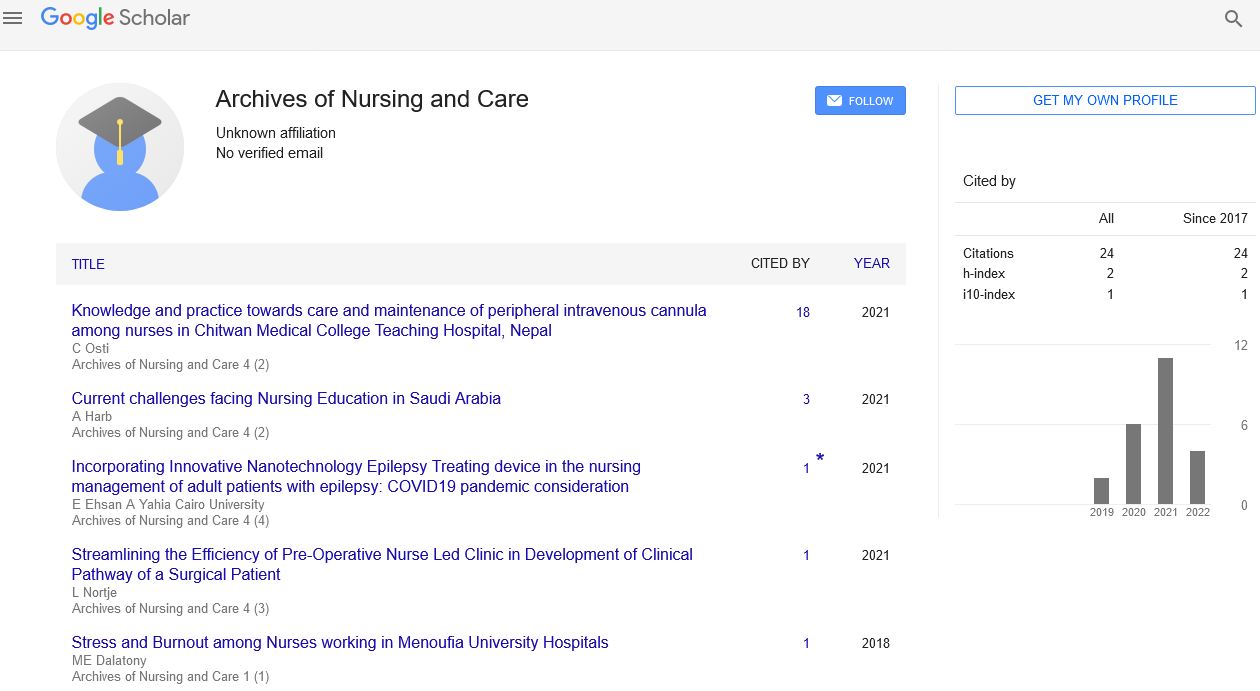Mini Review - Archives of Nursing and Care (2023) Volume 6, Issue 1
Mini review on Nursing Care for Neonates
Lilly Nilsson*
Department of Women's and Children's Health, Sweden
Department of Women's and Children's Health, Sweden
E-mail: nilssonlilly@rediff.com
Received: 02-Jan-2023, Manuscript No. OANC-23-87392; Editor assigned: 04-Jan-2023, PreQC No. OANC-23-87392 (PQ); Reviewed: 18-Jan-2023, QC No. OANC-23- 87392; Revised: 23-Jan-2023, Manuscript No. OANC-23-87392 (R); Published: 30-Jan-2023; DOI: 10.37532/oanc.2023.6(1).013-015
Abstract
The thread that binds a patient's medical journey together is modern nursing. Nurses work relentlessly to recognise and safeguard the requirements of the person throughout the whole patient experience and wherever there is someone in need of care. Beyond the well-established reputation for compassion and commitment, there is a highly specialised field that is continually changing to meet societal requirements. Nurses are crucial to preserving public health because they guarantee the most precise diagnosis and continuously educate the public about important health concerns. An art and a science, a heart and a mind, can be said to be involved in nursing. Its core values include a basic regard for human dignity and an awareness of the requirements of the patient. The mind provides assistance for this in the form of strong core education. Each nurse will have distinct talents, passions, and expertise because of the wide variety of specialisations and complicated abilities required in the nursing profession. But there is a guiding principle in nursing: Nurses don't merely look at test findings when evaluating a patient. Nurses employ their judgement to combine objective data with subjective experience of a patient's biological, physical, and behavioural requirements through the critical thinking demonstrated in the nursing process. This guarantees that every patient, regardless of who they are or where they may be, receives the greatest care available, whether they are at a city hospital, community health centre, state jail, or summer camp.
Nursing Care for Neonates (new born)
When a new-born needs respiratory assistance, it's important to keep an eye out for any minor changes that can indicate the need for weaning or a worsening that calls for further treatment. These new-borns should be cared for by an interdisciplinary team with experience in treating tiny and unwell infants. All healthcare professionals, including nurses, must have a solid grasp of pathophysiology, pharmacotherapy, developmental physiology, and the requirements of the baby and family. It is becoming increasingly obvious as we learn more about the morbidities that affect very low birth weight babies and other new-borns who require respiratory support that technology alone will not lead to further improvements in outcome unless it is combined with meticulous attention to the neonate's environment and the minute details that lead to an ideal outcome. Because nurses spend the most time at the patient's bedside, they are more likely to be familiar with the newborn and to notice changes in their condition [1-5].
When a new-born is admitted to the neonatal intensive care unit (NICU), they should be evaluated, as well as at regular intervals during the day. Every bodily system is assessed, as per unit policy, at least once every shift, and the results are recorded in the medical file. Reviewing the history of the family, mother, labour and delivery, as well as issues and interventions since birth is crucial before diagnosing the child. Depending on the infant's gestational and chronological age, different results might be anticipated.
Before upsetting the baby, an observational time should be used to do the assessment. The next steps are palpation and auscultation. General observation includes the infant's tone, colour, and amount of activity. It is important to take notice of any mucous membrane or lip cyanosis. Acrocyanosis is prevalent, especially in the first few days and hours following delivery; all newborns should be centrally pink. Term babies are typically flexible and alternate between periods of activity and sleep. Since premature newborns are more likely to have lower tone and activity levels, it's crucial to watch each one carefully over time for any small changes. In term new-borns who have reached their full growth potential, the chest circumference is between 30 and 36 cm in diameter, or about 2 cm smaller than the occipital-frontal head circumference. A barrel chest with an increase in the anteroposterior diameter is seen in conditions associated with air trapping such as meconium aspiration, advanced chronic lung disease, or transient tachypnea of the new-born, whereas infants with pulmonary hypoplasia or neuromuscular abnormalities may have a small or bell-shaped chest [6-8]. It is important to look at the chest's symmetry, contour, and mobility. The function of respiration, the employment of auxiliary muscles, and chest wall movement are all given special consideration. 30 to 60 breaths per minute at a relaxed diaphragmatic pace constitute normal breathing. One of the most prevalent signs of respiratory illness, particularly those that have low compliance like respiratory distress syndrome, is tachypnea (RDS). Although they prefer to breathe through their noses, infants will frequently breathe through their mouths if their nasal passages are blocked. When ventilator pressures are higher than what is necessary for proper gas exchange, excessive chest wall excursion may be observed in newborns undergoing mechanical ventilation.
Reduced chest wall movement may indicate a reduction in lung capacity due to atelectasis or an airway blockage. A pneumothorax may be present if the chest moves asymmetrically. When comparing one side to the other, the anterior and posterior surfaces of the chest should both be auscultated for breath sounds. When there are air leaks, atelectasis, or fluid in the pleural space, breath sounds are lessened. In the final stages of inspiration, infants with RDS may make mild breath noises that sound sandpapery. In the presence of consolidation, as with pneumonia, sounds may be amplified. As foetal lung fluid is expelled in the first few hours after delivery, little crackles are a common observation. After that point, new-borns with RDS or bronchopulmonary dysplasia may hear crackles (BPD). Fluid in the alveoli and airways is reflected by more noticeable crackles.
Although wheezes are uncommon in newborns, they can be heard in babies with BPD. Stridor is most frequently audible after extubation and results from upper airway blockage. Due to the airway restriction caused by the endotracheal tube, wheezes and rubs are more frequently heard in ventilated new-borns. Infants that get high-frequency ventilation will experience different breathing patterns, ranging from jackhammer-like jet ventilation to higher-pitched and vibratory noises. In the presence of secretions, higherpitched or melodic sounds can be detected. During an auscultation of the chest, the heart sounds are evaluated for any abnormalities, additional beats, or murmurs. To check for the presence of tumours, edoema, or subcutaneous emphysema, the chest is palpated. In babies who are getting highfrequency ventilation, it is also a helpful approach to evaluate air admission. Compare the two sides of the chest using the palm of the hand. A misplaced endotracheal tube, secretions, or an air leak may be indicated by differences in the intensity of the vibrations on one side of the chest compared to the other [9].
Nursing Care Plan
Care plans assist nurses in concentrating on patients holistically and comprehensively so they may provide evidence-based, patientcentered care. Care plans also assist hospitals in meeting paperwork requirements for insurers and regulating authorities, promoting inter-professional teamwork by having all professionals on the same page, and ensuring continuity of care throughout nurse shifts. There's a strong likelihood that your nurses aren't creating care plans for each patient because they are too busy, even if your hospital needs them. Depending on the unit, they may only provide care for a few days before being overburdened with unnecessary paperwork. Nurses may question the need for creating an official plan of care given that the majority of the data in one is already needed in various areas of each patient's electronic health record (EHR). Nurses are unlikely to create care plans unless they are necessary. Writing care plans will also be seen as extra "busywork," which is the misery of every nurse's existence, unless they are helpful [10].
Reference
- Armitage N, Trethewie S. Paediatric palliative care-the role of the GP. Australian Family Physician. 43, 176-180 (2014).
- Wood F, Simpson S, Barnes E et al. Disease trajectories and ACT/RCPCH categories in paediatric palliative care. Palliative Medicine. 24, 796-806 (2010).
- O’Leary N, Flynn J, MacCallion A et al. Paediatric palliative care delivered by an adult palliative care service. Palliative Medicine. 20, 433-437 (2006).
- Jünger S, Vedder AE, Milde S et al. Paediatric palliative home care by general paediatricians: a multimethod study on perceived barriers and incentives. BMC palliative care. 9, 1-12 (2010).
- Vadeboncoeur CM, Splinter WM, Rattray M et al. A paediatric palliative care programme in development: trends in referral and location of death. Archives of Disease in Childhood, 95, 686-689 (2010).
- Liben S, Papadatou D, Wolfe J. Paediatric palliative care: challenges and emerging ideas. The Lancet. 371, 852-864 (2008).
- WilliamsâReade J, Lamson AL, Knight SM, et al. Paediatric palliative care: a review of needs, obstacles and the future. Journal of Nursing Management. 23, 4-14 (2015).
- Hill K, Coyne I. Palliative care nursing for children in the UK and Ireland. British journal of nursing. 21, 276-281 (2012).
- Couch E, Mead JM, Walsh MM. Oral health perceptions of paediatric palliative care nursing staff. International journal of palliative nursing. 19, 9-15 (2013).
- Harrop E, Edwards C. How and when to refer a child for specialist paediatric palliative care. Archives of Disease in Childhood-Education and Practice. 98, 202-208 (2013).
Indexed at, Google Scholar, Crossref
Indexed at, Google Scholar, Crossref
Indexed at, Google Scholar, Crossref
Indexed at, Google Scholar, Crossref
Indexed at, Google Scholar, Crossref
Indexed at, Google Scholar, Crossref
Indexed at, Google Scholar, Crossref
Indexed at, Google Scholar, Crossref

